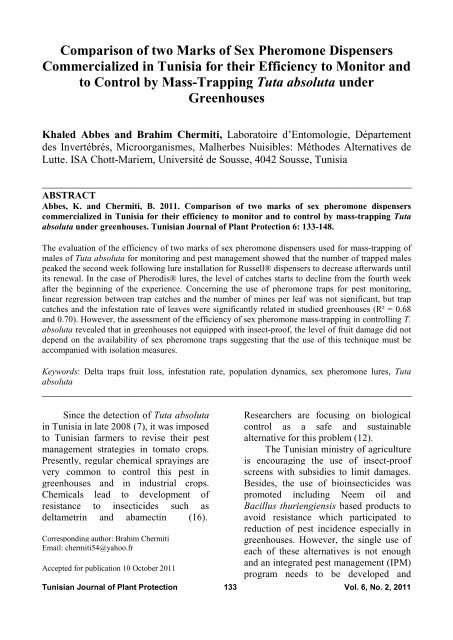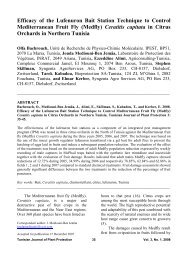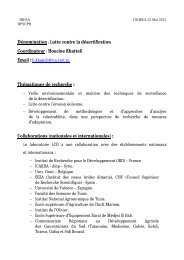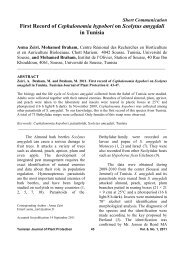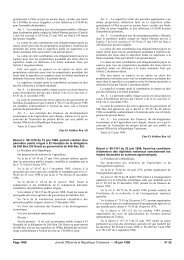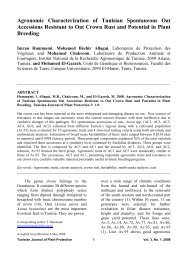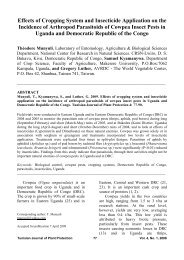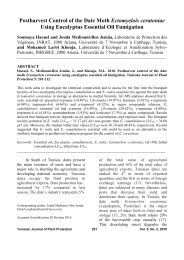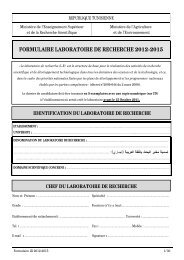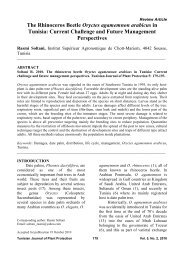Comparison of two Marks of Sex Pheromone Dispensers ... - Iresa
Comparison of two Marks of Sex Pheromone Dispensers ... - Iresa
Comparison of two Marks of Sex Pheromone Dispensers ... - Iresa
You also want an ePaper? Increase the reach of your titles
YUMPU automatically turns print PDFs into web optimized ePapers that Google loves.
<strong>Comparison</strong> <strong>of</strong> <strong>two</strong> <strong>Marks</strong> <strong>of</strong> <strong>Sex</strong> <strong>Pheromone</strong> <strong>Dispensers</strong><br />
Commercialized in Tunisia for their Efficiency to Monitor and<br />
to Control by Mass-Trapping Tuta absoluta under<br />
Greenhouses<br />
Khaled Abbes and Brahim Chermiti, Laboratoire d’Entomologie, Département<br />
des Invertébrés, Microorganismes, Malherbes Nuisibles: Méthodes Alternatives de<br />
Lutte. ISA Chott-Mariem, Université de Sousse, 4042 Sousse, Tunisia<br />
___________________________________________________________________________<br />
ABSTRACT<br />
Abbes, K. and Chermiti, B. 2011. <strong>Comparison</strong> <strong>of</strong> <strong>two</strong> marks <strong>of</strong> sex pheromone dispensers<br />
commercialized in Tunisia for their efficiency to monitor and to control by mass-trapping Tuta<br />
absoluta under greenhouses. Tunisian Journal <strong>of</strong> Plant Protection 6: 133-148.<br />
The evaluation <strong>of</strong> the efficiency <strong>of</strong> <strong>two</strong> marks <strong>of</strong> sex pheromone dispensers used for mass-trapping <strong>of</strong><br />
males <strong>of</strong> Tuta absoluta for monitoring and pest management showed that the number <strong>of</strong> trapped males<br />
peaked the second week following lure installation for Russell® dispensers to decrease afterwards until<br />
its renewal. In the case <strong>of</strong> Pherodis® lures, the level <strong>of</strong> catches starts to decline from the fourth week<br />
after the beginning <strong>of</strong> the experience. Concerning the use <strong>of</strong> pheromone traps for pest monitoring,<br />
linear regression between trap catches and the number <strong>of</strong> mines per leaf was not significant, but trap<br />
catches and the infestation rate <strong>of</strong> leaves were significantly related in studied greenhouses (R² = 0.68<br />
and 0.70). However, the assessment <strong>of</strong> the efficiency <strong>of</strong> sex pheromone mass-trapping in controlling T.<br />
absoluta revealed that in greenhouses not equipped with insect-pro<strong>of</strong>, the level <strong>of</strong> fruit damage did not<br />
depend on the availability <strong>of</strong> sex pheromone traps suggesting that the use <strong>of</strong> this technique must be<br />
accompanied with isolation measures.<br />
Keywords: Delta traps fruit loss, infestation rate, population dynamics, sex pheromone lures, Tuta<br />
absoluta<br />
___________________________________________________________________________<br />
Since the detection <strong>of</strong> Tuta absoluta<br />
in Tunisia in late 2008 (7), it was imposed<br />
to Tunisian farmers to revise their pest<br />
management strategies in tomato crops.<br />
Presently, regular chemical sprayings are<br />
very common to control this pest in<br />
greenhouses and in industrial crops.<br />
Chemicals lead to development <strong>of</strong><br />
resistance to insecticides such as<br />
deltametrin and abamectin (16).<br />
Corresponding author: Brahim Chermiti<br />
Email: chermiti54@yahoo.fr<br />
Accepted for publication 10 October 2011<br />
Researchers are focusing on biological<br />
control as a safe and sustainable<br />
alternative for this problem (12).<br />
The Tunisian ministry <strong>of</strong> agriculture<br />
is encouraging the use <strong>of</strong> insect-pro<strong>of</strong><br />
screens with subsidies to limit damages.<br />
Besides, the use <strong>of</strong> bioinsecticides was<br />
promoted including Neem oil and<br />
Bacillus thuriengiensis based products to<br />
avoid resistance which participated to<br />
reduction <strong>of</strong> pest incidence especially in<br />
greenhouses. However, the single use <strong>of</strong><br />
each <strong>of</strong> these alternatives is not enough<br />
and an integrated pest management (IPM)<br />
program needs to be developed and<br />
Tunisian Journal <strong>of</strong> Plant Protection 133 Vol. 6, No. 2, 2011
promoted to ensure a better control <strong>of</strong> this<br />
miner.<br />
Among IPM strategies, the use <strong>of</strong><br />
sex pheromone traps is one <strong>of</strong> the most<br />
recognized tactics against the tomato pest<br />
that is becoming increasingly used<br />
worldwide. The market <strong>of</strong> sex<br />
pheromones lures used for mass-trapping<br />
<strong>of</strong> males <strong>of</strong> the tomato miner T. absoluta<br />
is experiencing a boom in Tunisia where<br />
several marks <strong>of</strong> sex pheromone baits are<br />
commercialized. All these pheromone<br />
lures have the same active component<br />
which is a synthetic pheromone <strong>of</strong><br />
female, the 3E, 8Z, 11Z -3,8,11-<br />
tetradecatrien-1-yl acetate (13). The<br />
production technology can differ between<br />
products like the composition <strong>of</strong> the<br />
rubber capsules and the rate <strong>of</strong> diffusion<br />
<strong>of</strong> the pheromone into the air that<br />
determines its lifetime and consequently,<br />
its effectiveness.<br />
The aim <strong>of</strong> this study was: i) to<br />
compare the performance <strong>of</strong> <strong>two</strong> marks <strong>of</strong><br />
the most used sex pheromone capsules in<br />
Tunisia, ii) to find out if trap catches<br />
reflect the infestation level <strong>of</strong> the crop,<br />
iii) to assess the situation with and<br />
without sex pheromone traps under<br />
greenhouses unprotected by insect-pro<strong>of</strong>.<br />
Several parameters were studied like the<br />
number <strong>of</strong> trapped males, the abundance<br />
<strong>of</strong> the pest in the greenhouses and its<br />
population dynamics, the number <strong>of</strong><br />
mines caused by larvae, the infestation<br />
rate <strong>of</strong> tomato leaves and the fruit loss.<br />
MATERIALS AND METHODS<br />
Tomato greenhouses.<br />
Six commercial greenhouses with<br />
three tomato cultivars (Pacal, Colibri, and<br />
Sahel) situated in the tomato cropping<br />
area <strong>of</strong> Teboulba (Sahel, Tunisia) were<br />
provided for free by a local farmer who<br />
volunteered to submit them to the<br />
experience. Tomato greenhouses planted<br />
with cultivars Colibri and Pacal were<br />
situated next to each other while<br />
Control[1] with Pacal cultivar, without<br />
sex pheromone trap, was 100 m away.<br />
Tomato greenhouses Sahel1 and Sahel2,<br />
planted with the cultivar Sahel, were<br />
located close to each other and 100 m far<br />
from the greenhouse Control[2] <strong>of</strong> the<br />
same cultivar. The distance between<br />
greenhouses with different marks <strong>of</strong> sex<br />
pheromone dispensers was 1 km to avoid<br />
interference.<br />
Experimental greenhouses were 60<br />
m length, 8 m wide and 3 m height with a<br />
total area <strong>of</strong> 500 m². They were covered<br />
with <strong>two</strong> years old polyethylene screens.<br />
Tomato plants were transplanted on the<br />
end <strong>of</strong> December with a density <strong>of</strong> 3<br />
plants/m² and a total number <strong>of</strong> 1500<br />
plants/greenhouse. No insecticides were<br />
sprayed against T. absoluta in all<br />
greenhouses throughout the test period<br />
and the same cultural practices were<br />
performed in all the six experimental<br />
greenhouses.<br />
Mass-trapping.<br />
Colibri and Pacal tomato<br />
greenhouses were equipped with one<br />
delta trap each as recommended under<br />
greenhouses with a density <strong>of</strong> one trap per<br />
500 m² (5). Water traps were baited with<br />
sex pheromone capsules mark Pherodis®<br />
installed from 05/03/2009 to 10/06/2009.<br />
Two other Delta traps loaded with<br />
Russel® sex pheromone lures were<br />
installed in the greenhouses Sahel1 and<br />
Sahel2 during the period between<br />
15/04/2009 and 03/06/2009. Sticky<br />
cardboards in all mentioned traps were<br />
renewed once a week from the beginning<br />
<strong>of</strong> the observations till April 1 st and twice<br />
a week during the rest <strong>of</strong> the experience<br />
period due to the increase <strong>of</strong> the<br />
population <strong>of</strong> the insect and their rapid<br />
saturation. <strong>Sex</strong> pheromone capsules were<br />
renewed every 4 weeks and the number <strong>of</strong><br />
captured males <strong>of</strong> T. absoluta was<br />
Tunisian Journal <strong>of</strong> Plant Protection 134 Vol. 6, No. 2, 2011
ecorded every week before the change <strong>of</strong><br />
the sticky cardboards. Traps were<br />
removed on 10/06/2009 from Pacal and<br />
Colibri crops and on 03/06/2009 from<br />
Sahel1 and Sahel2 greenhouses. Both<br />
types <strong>of</strong> pheromone capsules were<br />
standard pheromone lures, loaded with<br />
0.5 mg <strong>of</strong> synthetic sex pheromone <strong>of</strong><br />
females <strong>of</strong> T. absoluta and bought from<br />
local suppliers.<br />
Sampling.<br />
In order to assess the infestation<br />
level in the experimental tomato crops<br />
with and without sex pheromone traps,<br />
sampling started on 05/03/2009 in Pacal<br />
and Colibri greenhouses and on<br />
19/03/2009 in Control[1] and took end on<br />
27/05/2009 and 03/06/2009, respectively.<br />
Sampling concerned the first fully<br />
developed leaf from the upper part <strong>of</strong><br />
tomato plants as recommended by<br />
Gravena (15). The number <strong>of</strong> samples<br />
was 20 leaves per unit. Greenhouses were<br />
divided into 20 equal plots and limits<br />
between plots were marked by white<br />
paint on the black plastic mulch. Every<br />
week, one tomato leaf was collected from<br />
each plot and from a different tomato<br />
plant. Sampled plants were marked with<br />
red plastic stickers so that they would not<br />
be used for next week sampling. Leaves<br />
were observed under binoculars type<br />
Leica® Model MS5 and all present<br />
instars <strong>of</strong> T. absoluta were identified and<br />
counted. Only one sampling was missed<br />
in Control[1] on 15/04/2009 because <strong>of</strong> a<br />
fungicide spraying.<br />
Damaged fruits as well as the total<br />
production <strong>of</strong> each greenhouse were<br />
weighted after each harvest using an<br />
electronic scale.<br />
Statistical analysis.<br />
A linear regression analysis between<br />
the total number <strong>of</strong> mines per leaf (with<br />
and without larvae) as well as the<br />
infestation rate and the number <strong>of</strong><br />
individuals per trap was performed in<br />
greenhouses Pacal and Colibri equipped<br />
with traps using GraphPad Prism Version<br />
5.00 to assess the efficiency <strong>of</strong><br />
pheromone Delta traps for monitoring.<br />
RESULTS<br />
Performance <strong>of</strong> tow marks <strong>of</strong> sex<br />
pheromone lures.<br />
<strong>Sex</strong> <strong>Pheromone</strong> Bait Pherodis®<br />
mark. The number <strong>of</strong> trapped males in<br />
Colibri greenhouse started relatively low<br />
with 98 individuals per week to reach a<br />
maximum <strong>of</strong> 852 adults on 20/05/2009.<br />
During this gradual increase, each<br />
renewal <strong>of</strong> the capsule was <strong>of</strong>ten<br />
followed by an increase in the number <strong>of</strong><br />
trapped adults (Fig. 1A).<br />
The figure <strong>of</strong> the evolution <strong>of</strong> masstrapping<br />
in Pacal greenhouse shows a<br />
similar shape to that <strong>of</strong> Colibri. Indeed,<br />
after 66 adults caught on 11/03/2009, the<br />
number <strong>of</strong> trapped males continued to<br />
increase steadily to exceed 883 on<br />
20/05/2009. The change <strong>of</strong> the<br />
pheromone bait on 27/05/2009 led to the<br />
raise <strong>of</strong> the number <strong>of</strong> caught males with<br />
a maximum <strong>of</strong> 961 individuals per trap<br />
recorded on 10/06/2009 in Pacal<br />
greenhouse. Besides, the renewal <strong>of</strong> the<br />
sticky boards tow times per week, starting<br />
from April 1 st , highly participated to the<br />
increase <strong>of</strong> trap efficiency (Fig. 1B).<br />
Tunisian Journal <strong>of</strong> Plant Protection 135 Vol. 6, No. 2, 2011
Fig. 1. Weekly evolution <strong>of</strong> trapped males <strong>of</strong> Tuta absoluta in greenhouses with Delta trap and Pherodis® sex<br />
pheromone lures in Teboulba in 2009. A: Greenhouse Colibri; B: Greenhouse Pacal; : Lure renewal.<br />
<strong>Sex</strong> <strong>Pheromone</strong> Bait Russel®<br />
mark. As far as greenhouses Sahel1 and<br />
Sahel2 were concerned, the level <strong>of</strong><br />
captures was important. In fact, the<br />
number <strong>of</strong> captured males was<br />
respectively about 455 and 346 after the<br />
first week <strong>of</strong> the trap installation. The<br />
level <strong>of</strong> trapped adults peaked during the<br />
third week after the beginning <strong>of</strong> the<br />
survey at 690 and 703 correspondingly<br />
in greenhouses Sahel1 and Sahel2. The<br />
reduction <strong>of</strong> the number <strong>of</strong> strained<br />
males <strong>of</strong> T. absoluta at an average <strong>of</strong> 276<br />
individuals per trap and per week,<br />
between 13/05/2009 and 20/05/2009, can<br />
be partially explained by the reduction <strong>of</strong><br />
the attractiveness <strong>of</strong> Russel® pheromone<br />
lures especially near the end <strong>of</strong> its<br />
lifetime. The renewal <strong>of</strong> both lures on<br />
13/05/2009 combined with the high level<br />
<strong>of</strong> population in May and June can<br />
explain in part the gradual increase <strong>of</strong><br />
the number <strong>of</strong> trapped males which<br />
reached 898 and 1111 per trap and per<br />
week on 27/05/2009 and 03/06/2009 in<br />
Sahel1 and Sahel2, respectively (Fig. 2).<br />
Efficiency <strong>of</strong> pheromone traps for<br />
monitoring.<br />
Tunisian Journal <strong>of</strong> Plant Protection 136<br />
One <strong>of</strong> the most important questions<br />
about the use <strong>of</strong> mass sex pheromone<br />
traps for monitoring this pest is: does the<br />
number <strong>of</strong> trapped males <strong>of</strong> T. absoluta in<br />
the sex pheromone bait traps reflects the<br />
real level <strong>of</strong> damage in tomato crops and<br />
the infestation rate <strong>of</strong> plants?<br />
To assess the relationship between<br />
trap catches, the infestation rates and the<br />
number <strong>of</strong> mines per leaf, a linear<br />
regression analysis was performed<br />
between the number <strong>of</strong> caught males <strong>of</strong><br />
T. absoluta in the sex pheromone traps<br />
equipped with Pherodis® lures, the<br />
number <strong>of</strong> mines per leaf and the<br />
infestation rate <strong>of</strong> leaves. Analysis<br />
showed a non significant relationship<br />
between the number <strong>of</strong> mines per leaf<br />
and the number <strong>of</strong> trapped males <strong>of</strong> the<br />
miner in both studied greenhouses (R² =<br />
0.26, P = 0.058 > 0.05 for Pacal and R² =<br />
0.18, P = 0.12 > 0.05 for Colibri) (Fig.<br />
3A, B). However, linear regression<br />
between the infestation rate <strong>of</strong> leaves and<br />
the number <strong>of</strong> catches in sex pheromone<br />
traps was highly significant in Pacal (R²<br />
= 0.68, P = 0.003 < 0.05) and Colibri (R²<br />
= 0.70, P = 0.0002 < 0.05) (Fig. 4A, B).<br />
Vol. 6, No. 2, 2011
Fig. 2. Weekly evolution <strong>of</strong> trapped males <strong>of</strong> Tuta absoluta in greenhouses with Delta trap and Russel® sex<br />
pheromone lures in Teboulba in 2009. A: Greenhouse Sahel1; B: Greenhouse Sahel2; : Lure renewal.<br />
Y= -0.0010X-18.16<br />
A<br />
Fig. 3. Linear regression between the number <strong>of</strong> caught males <strong>of</strong> Tuta absoluta and the number <strong>of</strong> mines per leaf<br />
in Pacal (A) (R² = 0.26) and Colibri (B) (R² = 0.18) in Teboulba in 2009 (Values at 95% confidence level).<br />
Efficiency <strong>of</strong> mass-trapping in<br />
pest management.<br />
Greenhouses with traps. Results <strong>of</strong><br />
Pacal and Colibri experimental<br />
greenhouses reflected the occurrence <strong>of</strong><br />
all instars <strong>of</strong> the pest on young tomato<br />
leaves with the continuous dominance <strong>of</strong><br />
eggs and first instar caterpillars during all<br />
the period <strong>of</strong> the study. However, the<br />
presence <strong>of</strong> older instars even with low<br />
Tunisian Journal <strong>of</strong> Plant Protection 137<br />
densities from March confirms that the<br />
infestation occurred earlier and started<br />
before the beginning <strong>of</strong> the experiment<br />
(Figs. 5A, 5B). The analysis <strong>of</strong> the<br />
population structure <strong>of</strong> T. absoluta on<br />
young tomato leaves in the <strong>two</strong> studied<br />
greenhouses revealed that the overall<br />
density <strong>of</strong> individuals per leaf remained<br />
low throughout March till mid-April.<br />
During this phase, the number <strong>of</strong><br />
Vol. 6, No. 2, 2011
individuals did not exceed 3 per leaf<br />
corresponding to a total number <strong>of</strong> larvae<br />
fewer than 2 per leaf (Fig. 6). One week<br />
later, T. absoluta population began to<br />
increase with favorable temperatures to<br />
reach 20 individuals per leaf in Pacal<br />
greenhouse on 27/05/2009 and 21<br />
individuals in Colibiri on 13/05/2009<br />
(Figs. 5A, 5B) corresponding to a total<br />
number <strong>of</strong> larvae peaking at 13.3 and 16.6<br />
larvae per leaf in Pacal and Colibri,<br />
respectively (Fig. 6). The maximum <strong>of</strong><br />
leaf mines was closely related to the<br />
density <strong>of</strong> T. absoluta caterpillars,<br />
especially that <strong>of</strong> neonate larvae. Indeed,<br />
peaks <strong>of</strong> mines in both crops<br />
corresponded perfectly to those <strong>of</strong> first<br />
instar larvae respectively recorded on<br />
27/05/2009 for Pacal and on 13/05/2009<br />
for Colibri greenhouses (Figs. 5B, 5D).<br />
In both greenhouses with<br />
pheromone traps, the maximum density<br />
<strong>of</strong> the pest on the crops, resulting mainly<br />
from the increase <strong>of</strong> the number <strong>of</strong> eggs<br />
on leaves, caused a high infestation rate<br />
around 100% on 22/04/2009 (Figs. 7B,<br />
7D). The damage caused by T. absoluta<br />
larvae on tomato leaves in both<br />
greenhouses led to a high density <strong>of</strong><br />
mines rising up to an average <strong>of</strong> 26 mines<br />
per leaf starting from 13/05/2009 (Figs.<br />
7A, 7C).<br />
In the first half <strong>of</strong> May, all the<br />
studied parameters were at their<br />
maximum with an infestation rate <strong>of</strong><br />
young leaves around 100% and an<br />
average <strong>of</strong> 30 mines per leaf. The end <strong>of</strong><br />
the experiment was characterized by a<br />
reduction <strong>of</strong> the density <strong>of</strong> all instars on<br />
tomato leaves.<br />
Y=0.050X+9.10<br />
Fig. 4. Linear regression between the number <strong>of</strong> caught males <strong>of</strong> Tuta absoluta and the infestation rate <strong>of</strong> leaves<br />
in Pacal (A) (R² = 0.68) and Colibri (B) (R² = 0.70) in Teboulba in 2009 (Values at 95% confidence level).<br />
Tunisian Journal <strong>of</strong> Plant Protection 138<br />
Vol. 6, No. 2, 2011
Fig. 5. Population dynamics <strong>of</strong> Tuta absoluta under greenhouses with sex pheromone Delta traps in Teboulba in<br />
2009. A: Pacal; B: Colibri; W: eggs; L1: first instar larvae; L2: second instar larvae; L3: third instar larvae; L4:<br />
fourth instar larvae; N: nymphs.<br />
Fig. 6. Evolution <strong>of</strong> the total number <strong>of</strong> Tuta absoluta larvae per leaf in Colibri and Pacal tomato<br />
cultivars.<br />
Tunisian Journal <strong>of</strong> Plant Protection 139<br />
Vol. 6, No. 2, 2011
B<br />
C<br />
D<br />
Fig. 7. Weekly evolution <strong>of</strong> the infestation rate and the average number <strong>of</strong> mines <strong>of</strong> Tuta absoluta on tomato<br />
leaves in greenhouses with sex pheromone Delta traps in Teboulba in 2009. A and B: Pacal; C and D: Colibri.<br />
Greenhouses without traps.<br />
Population dynamics <strong>of</strong> T. absoluta in<br />
Control[1], without sex pheromone trap,<br />
followed almost the same pattern as<br />
greenhouses equipped with Delta traps<br />
baited with sex pheromone lures. Indeed,<br />
throughout the month <strong>of</strong> March, the<br />
overall density <strong>of</strong> all biological instars <strong>of</strong><br />
the pest hardly exceeded 3.5 individuals<br />
per leaf with predominance <strong>of</strong> eggs.<br />
During the month <strong>of</strong> May, the population<br />
increased significantly and continuously,<br />
reaching a maximum <strong>of</strong> 25 individuals<br />
Tunisian Journal <strong>of</strong> Plant Protection 140<br />
(Fig. 8) and 15.17 larvae per leaf on<br />
27/05/2009 (Fig. 9) causing a raising<br />
infestation rate around 100% on<br />
06/05/2009 (Fig. 10B).<br />
The number <strong>of</strong> leaf mines was<br />
initially low on March and April, and<br />
increase during May to reach a maximum<br />
<strong>of</strong> 37 mines per leaf on 03/06/2009 (Fig.<br />
10A). The same decline <strong>of</strong> population<br />
observed in greenhouses with pheromone<br />
traps at the end <strong>of</strong> May was recorded<br />
again in Control[1].<br />
Vol. 6, No. 2, 2011
Fig. 8. Population dynamics <strong>of</strong> Tuta absoluta on tomato leaves in Control[1], without sex pheromone<br />
trap, in Teboulba in 2009. W: eggs; L1: first instar larvae; L2: second instar larvae; L3: third instar<br />
larvae; L4: fourth instar larvae; N: nymphs.<br />
Fig.9. Evolution <strong>of</strong> the total number <strong>of</strong> Tuta absoluta larvae per tomato leaf in the Control[1]<br />
greenhouse.<br />
Tunisian Journal <strong>of</strong> Plant Protection 141<br />
Vol. 6, No. 2, 2011
Fig. 10. Weekly evolution <strong>of</strong> the average number <strong>of</strong> mine <strong>of</strong> Tuta absoluta (A) and the infestation rate (B)<br />
on tomato leaves in the Control[1] greenhouse, without sex pheromone traps in Teboulba in 2009.<br />
B<br />
Tomato fruit loss.<br />
Loss <strong>of</strong> tomato fruits in<br />
experimental greenhouses was<br />
considerable. Indeed, they became<br />
obvious from 15/04/2009 with around 50<br />
kg/greenhouse, but with the growing <strong>of</strong><br />
T. absoluta population, damage has<br />
become increasingly important reaching<br />
1440 kg for a total harvest <strong>of</strong> 3280 kg in<br />
Colibri greenhouse, representing 43.90%<br />
loss (Fig. 11C). As for Pacal greenhouse,<br />
the damage caused by this pest was<br />
about 1290 kg for a total production <strong>of</strong><br />
2980 kg, representing 43.28% <strong>of</strong> yield<br />
loss (Fig. 11D). Fruit loss in Control[1]<br />
greenhouse was 1570 kg <strong>of</strong> a total<br />
production <strong>of</strong> 3720 kg corresponding to<br />
42.22% <strong>of</strong> the total harvest, similarly to<br />
greenhouses with sex pheromone traps.<br />
Loss in Control[2] greenhouse was about<br />
18.35% (Fig. 11B).<br />
DISCUSSION<br />
The high number <strong>of</strong> caught<br />
individuals <strong>of</strong> T. absoluta per week in<br />
Delta traps with Russel® sex pheromone<br />
lures was probably due to a greater<br />
attractiveness <strong>of</strong> this lure towards males<br />
<strong>of</strong> the tomato miner or may be a<br />
consequence <strong>of</strong> a superior level <strong>of</strong><br />
populations in the greenhouses where<br />
evaluation took place. <strong>Pheromone</strong> lures<br />
were not evaluated in the same<br />
greenhouse to avoid interference.<br />
However, some evaluation works <strong>of</strong> sex<br />
pheromone lures <strong>of</strong> T. absoluta and their<br />
longevity were carried out in Spain like<br />
that <strong>of</strong> Alfaro et al. (2) who used one<br />
greenhouse to evaluate 6 pheromone<br />
dispensers <strong>of</strong> different marks with weekly<br />
rotation <strong>of</strong> traps loaded with different<br />
types <strong>of</strong> capsules. They concluded that<br />
the pheromone capsule type Trécé179®<br />
has a higher level <strong>of</strong> capture and a better<br />
longevity. The area <strong>of</strong> the greenhouse<br />
used for this experiment was not<br />
mentioned in the paper but even in a big<br />
one and rotation <strong>of</strong> Delta traps, the risk <strong>of</strong><br />
interference is still high. In open field<br />
conditions, a distance <strong>of</strong> 25 m between<br />
traps may reduce trap interference.<br />
Tunisian Journal <strong>of</strong> Plant Protection 142<br />
Vol. 6, No. 2, 2011
A<br />
B<br />
C<br />
D<br />
E<br />
F<br />
Fig. 11. Cumulated loss <strong>of</strong> tomato fruits due to Tuta absoluta infestation recorded in the experimental<br />
greenhouses in Teboulba in 2009. A: Control[1]; B: Control[2]; C: Colibri; D: Pacal; E: Sahel1; F: Sahel2.<br />
Tunisian Journal <strong>of</strong> Plant Protection 143<br />
Vol. 6, No. 2, 2011
Concerning the second type <strong>of</strong><br />
tested pheromone lures, the average <strong>of</strong><br />
weekly catches in traps with Pherodis®<br />
dispensers was in constant increase even<br />
after the first four weeks <strong>of</strong> the beginning<br />
<strong>of</strong> the experiment. However the slight<br />
decrease <strong>of</strong> catches recorded between<br />
15/04/2009 and 29/04/2009 in greenhouse<br />
Pacal could be explained by the end <strong>of</strong><br />
the life time <strong>of</strong> the lure. Another decrease<br />
in the number <strong>of</strong> caches in both<br />
greenhouses with Delta traps and<br />
Pherodis® pheromone baits was observed<br />
on 20/05/2009, three weeks after the<br />
renewal <strong>of</strong> the lures. The number <strong>of</strong><br />
strained males <strong>of</strong> T. absoluta declined<br />
from 852 to 532 and from 883 to 442 in<br />
Colibri and Pacal greenhouses,<br />
respectively. As pheromones are very<br />
volatile, this sharp decrease can be<br />
explained by the elevated temperatures<br />
which increased from an average <strong>of</strong><br />
16.25°C in April to 19.6°C (6) in May<br />
that can accelerate the release <strong>of</strong> the<br />
pheromone from the rubber septa (4).<br />
In the case <strong>of</strong> Russel® pheromone<br />
capsules, there was a significant reduction<br />
<strong>of</strong> catches in the traps even in April<br />
characterized with cool temperature (11<br />
to 20°C) (6). By the end <strong>of</strong> the fourth<br />
week from the second renewal <strong>of</strong> the lure<br />
on 13/05/2009, the number <strong>of</strong> catches was<br />
350 to 450 individuals less.<br />
Based on these results, we can<br />
deduce that Russel® capsules may have<br />
greater attractiveness toward males <strong>of</strong> the<br />
tomato leaf miner than those <strong>of</strong><br />
Pherodis® due to the high number <strong>of</strong><br />
attracted males immediately after its<br />
installation, but the number <strong>of</strong> strained<br />
males <strong>of</strong> the miner decreased significantly<br />
from the second week. In the other hand,<br />
Pherodis® pheromone lures have<br />
apparently better performance due to the<br />
relatively high number <strong>of</strong> trapped males<br />
even four weeks after their installation.<br />
Results <strong>of</strong> linear regression between<br />
the number <strong>of</strong> trapped males and the<br />
infestation level suggest the utilization <strong>of</strong><br />
the sex pheromone traps as good<br />
indicators <strong>of</strong> the infestation rate <strong>of</strong> the<br />
crop. Some authors recommend 30<br />
trapped males per trap and per week to<br />
start chemical curative measures (4).<br />
Monitoring is very important in IPM<br />
programs; it allows the detection <strong>of</strong> the<br />
early infestations. Sprayings <strong>of</strong> chemicals<br />
based on data from pheromones traps are<br />
usually more effective in controlling first<br />
attacks and avoiding the rapid<br />
colonization <strong>of</strong> the crop. This can<br />
significantly reduce the number <strong>of</strong><br />
sprayed insecticides, and preserve natural<br />
enemies <strong>of</strong> the pest. For instance, Merid<br />
bug Nesidiocoris tenuis, an efficient<br />
natural enemy <strong>of</strong> T. absoluta, especially<br />
in open field (1), was very influenced by<br />
chemicals in Brazil where pest control<br />
was mainly based on heavy insecticide<br />
sprays reaching 36 treatments per season<br />
(14). Cônsoli et al. (11) reported a<br />
decrease in parasitism <strong>of</strong> Trichogramma<br />
pretiosum by application <strong>of</strong> tebufenozide.<br />
The assessment <strong>of</strong> the efficiency <strong>of</strong><br />
sex pheromone mass-trapping as pest<br />
management technique in Pacal and<br />
Colibri greenhouses as compared to<br />
Control[1] showed a relatively lower pest<br />
density than in greenhouses equipped<br />
with sex pheromone traps. However, the<br />
infestation rate and the number <strong>of</strong> mines<br />
per leaf were similar in different<br />
greenhouses. The decrease <strong>of</strong> the density<br />
<strong>of</strong> the pest population at the end <strong>of</strong> the<br />
survey is probably due to the widespread<br />
devastation <strong>of</strong> the canopies <strong>of</strong> tomato<br />
plants due to the high number <strong>of</strong> feeding<br />
larvae, causing a decrease <strong>of</strong> the number<br />
<strong>of</strong> eggs and juvenile instars on leaves.<br />
Indeed, young leaves are preferential<br />
oviposition sites for T. absoluta females<br />
which move to lay eggs on stems and<br />
Tunisian Journal <strong>of</strong> Plant Protection 144 Vol. 6, No. 2, 2011
especially fruits causing considerable<br />
losses.<br />
Fruit loss in experimental crops was<br />
similar and does not depend on the<br />
availability <strong>of</strong> sex pheromone traps in the<br />
greenhouses. Admittedly, sex pheromone<br />
traps attract a considerable number <strong>of</strong><br />
males and therefore may reduce<br />
possibilities <strong>of</strong> mating and oviposition on<br />
tomato plants. This is true only when<br />
greenhouses are isolated with an insectpro<strong>of</strong><br />
to avoid gravid females coming<br />
from outside. In the opposite case, the<br />
trap can attract a significant number <strong>of</strong><br />
males from the outside and may increase<br />
the mating probabilities inside the<br />
greenhouse especially when the sex<br />
pheromone baits are old and attracted<br />
males are not trapped. This can explain<br />
the situation in greenhouses Sahel1 and<br />
Sahel2 equipped with sex pheromone<br />
traps which showed an average loss <strong>of</strong><br />
1155 kg compared to an average total<br />
production <strong>of</strong> 4240 kg, corresponding to<br />
27% damage (Fig. 11F). Hence, fruit loss<br />
in Control[2] greenhouse <strong>of</strong> the same<br />
cultivar, not equipped with a sex<br />
pheromone trap, was 760 kg for a total<br />
production <strong>of</strong> 4140 kg representing<br />
18.35% <strong>of</strong> non commercialized fruits<br />
which means 8.65% less damage.<br />
Chermiti et al. (10) found that fruit loss<br />
was between 11 and 43.33% <strong>of</strong> the total<br />
yield in greenhouses with similar<br />
conditions. In the same context, Caffarini<br />
et al. (9) reported non significant<br />
regression between damaged leaf areas<br />
and fruit injuries in case <strong>of</strong> low<br />
infestation levels <strong>of</strong> T. absoluta. In other<br />
words, fruit loss was unpredictable (R² =<br />
0). Therefore, it is clear that the use <strong>of</strong><br />
mass-trapping alone for controlling T.<br />
absoluta is not sufficient and may even<br />
worsen the situation; so it must be<br />
accompanied at least by the use <strong>of</strong> insectpro<strong>of</strong><br />
and strict isolation measures in<br />
greenhouse doors (double door system)<br />
and aeration windows and if necessary<br />
additional chemical sprayings.<br />
Nevertheless, the wrong use <strong>of</strong> insectpro<strong>of</strong><br />
can cause high temperature and<br />
relative humidity inside greenhouses<br />
leading to fungal attacks (Grey mold, late<br />
blight, etc…) as well as extra production<br />
charges.<br />
Independently <strong>of</strong> the level <strong>of</strong><br />
population in studied greenhouses, tested<br />
pheromone lures showed different<br />
performance among the experiment<br />
period. Pherodis® lures were relatively<br />
more stable since they ensured a high<br />
number <strong>of</strong> trapped males even after four<br />
weeks <strong>of</strong> their installation which is not<br />
the case for Russel® lures where a<br />
significant decrease <strong>of</strong> the level <strong>of</strong><br />
strained males was observed.<br />
Mass-trapping can be an interesting<br />
technique to monitor and to control the<br />
tomato pest T. absoluta especially in an<br />
IPM program. However, special<br />
precautions should be taken such as the<br />
choice <strong>of</strong> sex pheromone capsules which<br />
must have a sufficient longevity (4-5<br />
weeks) and constant rate <strong>of</strong> pheromone<br />
release, the use <strong>of</strong> insect-pro<strong>of</strong> to prevent<br />
the infiltration <strong>of</strong> adults from outside and<br />
the regular renewal <strong>of</strong> the capsules<br />
according to recommendations <strong>of</strong> the<br />
producer. Besides, pheromone dose in the<br />
lures must be analyzed before importation<br />
in credible laboratories to guarantee their<br />
quality.<br />
Within IPM strategies, sex<br />
pheromone mass-trapping could be very<br />
promising to help establishment <strong>of</strong> both<br />
exotic and endemic natural enemies <strong>of</strong><br />
this pest and reduce high costs <strong>of</strong><br />
chemical control as well as side effect on<br />
beneficial insects (19). However, experts<br />
are very concerned about “arbitrary mass<br />
promotion” <strong>of</strong> T. absoluta pheromones to<br />
untrained farmers and the abusive use <strong>of</strong><br />
this technique as a “political quick fix” <strong>of</strong><br />
the problem. <strong>Pheromone</strong>s should not be<br />
Tunisian Journal <strong>of</strong> Plant Protection 145 Vol. 6, No. 2, 2011
considered in any case as “feel good<br />
factor”. While companies are focusing on<br />
increasing dosing level in pheromones<br />
dispenser looking for more effective<br />
mass-trapping product, little work was<br />
done to study the influence <strong>of</strong> other<br />
factors on mass-trapping such us trap<br />
design. Fernando et al. (13) proved that<br />
this latter can significantly influence trap<br />
capture which was recently confirmed in<br />
recent studies in Morocco (3). The<br />
combination <strong>of</strong> super dosed pheromone<br />
capsules with inefficient trap designs<br />
raises concerns about possibilities to an<br />
increase in insect population in<br />
greenhouses and potential amplification<br />
in damage especially that farmers are<br />
making their own traps in the most <strong>of</strong> the<br />
invaded countries. Researches need to be<br />
continued with sex pheromones <strong>of</strong> T.<br />
absoluta to develop a reliable technique<br />
<strong>of</strong> sexual confusion which is potential<br />
management strategy (17, 18).<br />
ACKNOWLEDGEMENTS<br />
The authors thank the General Directorate <strong>of</strong><br />
the Protection and the Control <strong>of</strong> the Agricultural<br />
Product Quality (Ministry <strong>of</strong> Agriculture) and Mrs.<br />
Naziha Trimech from Agricultural Service<br />
Cooperative “ESSAADA”, Teboulba, for their<br />
serious involvement to achieve this field work.<br />
___________________________________________________________________________<br />
RESUME<br />
Abbes K. et Chermiti B. 2011. Comparaison de l’efficacité de deux marques de capsules à<br />
phéromone sexuelle commercialisées en Tunisie pour la surveillance et la lutte par le piégeage de<br />
masse contre Tuta absoluta sous serres. Tunisian Journal <strong>of</strong> Plant Protection 6: 133-148.<br />
L’évaluation de l’efficacité de deux marques de capsules à phéromones sexuelles utilisées dans le<br />
piégeage de masse des mâles de Tuta absoluta comme un moyen de détection et de lutte a montré que<br />
le volume des captures atteint son maximum à la deuxième semaine pour les capsules Russel® pour<br />
diminuer par la suite jusqu’à son renouvellement. Dans le cas de la capsule Pherodis®, le niveau des<br />
captures commence à diminuer à partir de la quatrième semaine de l’installation de la capsule.<br />
Concernant l’utilisation des pièges à phéromone sexuelle pour la surveillance des populations, la<br />
régression linéaire entre le niveau des captures et le nombre des galeries par feuille était non<br />
significative; alors que le taux d’infestation et le nombre des captures dans les pièges étaient<br />
significativement liés dans les serres étudiées (R² = 0,68 et 0,70); ceci suggère son emploi comme un<br />
indicateur du niveau d’infestation des cultures de tomate pour la prise de décision. Cependant,<br />
l'évaluation de l'efficacité de piégeage de masse a révélé que le niveau de dégâts sur les fruits ne<br />
dépend pas de la pose des pièges à phéromone sexuelle, mais plutôt de l’isolation de la serre du milieu<br />
extérieur par des filets insect-pro<strong>of</strong>.<br />
Mots clés: Capsules à phéromone sexuelle, dynamique des populations, pertes en fruits, pièges Delta,<br />
taux d’infestation, Tuta absoluta<br />
___________________________________________________________________________<br />
.2011<br />
الطماطم/البندورة Tuta absoluta<br />
Tunisian Journal <strong>of</strong> Plant Protection 6: 133-148.<br />
ملخص<br />
عباس، خالد وبراهيم شرميطي.<br />
لرصد ومكافحة حافرة<br />
مقارنة فعالية نوعين من آبسولات الفيرومون الجنسي المسوقة في تونس<br />
باستعمال الصيد المكثف.<br />
اهتمت هذه الدراسة بمقارنة نوعين من آبسولات الفرومون المستخدمة في المصائد الفيرومونية لحافرة الطماطم/<br />
البندورة. وقد بينت أن عدد الفراشات الممسوآة يبلغ أقصاه في الأسبوع الثاني من بدء استعمال المصيدة بالنسبة للكبسولة<br />
فإن عدد<br />
من نوع Russel® لتنخفض بعد ذلك حتى موعد تغييرها. أما بالنسبة إلى الكبسولة من نوع<br />
الفراشات الممسوآة لا ينخفض إلا انطلاقا من الأسبوع الرابع. أآدت هذه الدراسة عدم وجود علاقة بين عدد الفراشات<br />
الممسوآة وعدد الأنفاق في الأوراق ولكن وجود علاقة وثيقة بين نسبة إصابة الأوراق وعدد الفراشات في المصيدة = R²)<br />
Pherodis®<br />
Tunisian Journal <strong>of</strong> Plant Protection 146 Vol. 6, No. 2, 2011
مما يشير إلى إمكانية الاعتماد على المصائد الفيرومونية آمؤشر جيد على مستوى الإصابة لأخذ التدابير<br />
اللازمة. بين تقييم مدى نجاعة تقنية المكافحة باستعمال المصائد الفيرومونية في الدفيئات دون وضع شباك واقية من<br />
الحشرات أن مستوى إصابة الثمار لا يعتمد على وجود المصائد الفيرومونية من عدمه وان استعمال هذه الأخيرة يجب أن<br />
يكون مصاحبا بإجراءات عزل.<br />
0.68 0.70)<br />
آلمات مفتاحية: آبسولات فيرومونية، دينامكية المجتمع الحشري، خسائر الثمار، مصيدة دلتا، نسبة الإصابة.<br />
___________________________________________________________________________<br />
LETERATURE CITED<br />
1. Abbes, K. and Chermiti B. 2010. Integrated pest<br />
management essay against the tomato leafminer<br />
Tuta absoluta Povolny (Lepidotera:<br />
Gelecheiidae) in an open field tomato crop in<br />
the region <strong>of</strong> Raggueda, Tunisia. African J.<br />
Plant Sci. Biotech. 3: 91-95.<br />
2. Alfaro, C., Vacas, S., Vicente, N., and Jaime, P.<br />
2009. Evaluciόn de Emisores Comerciales de<br />
feromona para el seguimiento poblacional de la<br />
polilla del tomate Tuta absoluta (Povolny).<br />
Agricola Vergel: Fruticultura, Horticultura,<br />
Floricultutra 326: 124-128.<br />
3. Anonymous, 2009. Feell good factor is not the<br />
way to use pheromone in the fight against Tuta<br />
absoluta. http: //www.tutaabsoluta.com/<br />
4. Anonymous, 2009. FREDON, Corse, Mesures<br />
de lute contre Tuta absoluta. Fédération<br />
Régionale de Lutte et de Défense contre les<br />
Organismes Nuisibles-Corse. 4 pp.<br />
5. Anonymous, 2009.<br />
http://www.koppert.com/products/monitoring/p<br />
roducts-monitoring/detail/pherodis-2/<br />
6. Anonymous, 2009. Institut Nationale de la<br />
Météorologie de Tunisie. http://www.meteo.tn<br />
7. Anonymous, 2009. OEPP/EPPO Service<br />
d’information. 5 pp.<br />
http://www.archives.eppo.org/EPPOReporting/<br />
2009/Rsf-0903.pdf/<br />
8. Armstrong, J.S., Supergeon, D.W., and Suhic,<br />
P.C. 2006. <strong>Comparison</strong>s <strong>of</strong> standard and<br />
extended-life Boll weevil (Coleoptera:<br />
Curculionidae) pheromone lures. J. Econom.<br />
Entomol. 99: 323-330.<br />
9. Caffarini, P.M., Folia, A.M., Panzaradi, S.R.,<br />
and Pérez, A. 1999. Incidencia de bajos niveles<br />
de daño foliar de Tuta absoluta (Maeyrick) en<br />
tomate. Bol. San. Veg. Plagas. 25: 75-78.<br />
10. Chermiti, B., Abbes, K., Aoun, M., Ben<br />
Othmane, S., Ouhibi, M., Gamoon, W., and<br />
Kacem, S. 2009. First estimate <strong>of</strong> Tuta absoluta<br />
(Povolny) (Lepidoptera: Gelecheiidae) and<br />
evaluation <strong>of</strong> the efficiency <strong>of</strong> sex pheromone<br />
traps in greenhouses <strong>of</strong> tomato crops in the<br />
Bekalta region. African J. Plant Sci. Biotech. 3:<br />
49-52.<br />
11. Cônsoli, F.L., Parra, G.R.P., and Hassan, S.A.<br />
1998. Side-effects <strong>of</strong> insecticides used in<br />
tomato fields on the egg parasitoid<br />
Trichogramma pretiosum Reley (Hym.,<br />
Trichogrammatidae), a natural enemy <strong>of</strong> Tuta<br />
absoluta (Merick) (Lep., Gelechiidae). J. Appl.<br />
Entomol. 122: 43-47.<br />
12. Desneux, N., Wajnberg, N.W., Wychuys,<br />
K.A.G., Brugio, G., Arpaia, S., Narvaez-<br />
Vasquez, C.A., Gonzales-Cabrera, J., Ruescas,<br />
C., Tabone, E., Frandon, J., Pizzol, J., Poncet,<br />
C., Cabello, T., and Urbaneja, A. 2010.<br />
Biological invasión <strong>of</strong> European tomato crops<br />
by Tuta absoluta: Ecology, geographic<br />
expansión and prospects for biological control.<br />
J. Pest. Sci. 83: 197-215.<br />
13. Fernando, A.A.F., Evaldo, F.V., Gulban, N.J.,<br />
Álvaro, E.E., Marcelo, C.P., Athula, B.A., Ales,<br />
S., Rosa, T.S.F., and Jerrold, M. 2001.<br />
Evaluation <strong>of</strong> major component <strong>of</strong> the sex<br />
pheromone <strong>of</strong> Tuta absoluta (Meyrick)<br />
(Lepidoptera: Gelechiidae). J. Chem. Ecol. 27:<br />
907-917.<br />
14. Filho, M.M., Vilela, E.F., Jham, J.M.,<br />
Attygalle, A., Svatos, A., and Meinwald, J.<br />
2000. Initial studies <strong>of</strong> mating disruption <strong>of</strong> the<br />
tomato moth, Tuta absoluta (Lepidoptera:<br />
Gelechiidae) using synthetic sex pheromone. J.<br />
Braz. Chem. Soc. 11: 621-628.<br />
15. Gravena, S. 1991. Manejo integrado de pragas<br />
do tomateiro. Pages 105-157. In Proceedings <strong>of</strong><br />
2 nd Encontro Nacional de Produção e<br />
Abastecimento de Tamate. October 8-11, 1991,<br />
Jaboticabal, Brazil.<br />
16. Lietti, M.M.M., Botto, E., and Alzogara, R.<br />
2005. Insecticide resistance in Argentine<br />
populations <strong>of</strong> Tuta absoluta<br />
(Meyrick)(Lepidoptera: Gelechiidae). Neotr.<br />
Entomol. 34: 113-119.<br />
17. Martí, S.M., Muñoz, M.C., and Casagrande, E.<br />
2010. El uso de feromonas para el control de<br />
Tuta absoluta: Primeras Experiencias en<br />
Campo. Phytoma-La Défense des Végétaux<br />
217: 35-38.<br />
18. Navarro, V.L., Alfaro, C., Vaca, S., and Primo,<br />
J. 2010. Applicaciόn de la confuciόn sexual al<br />
control de la polilla del tomate Tuta absoluta<br />
Povolny (Lepidoptera: Gelecheiidae). Phytoma-<br />
La Défense des Végétaux 217: 32-34.<br />
Tunisian Journal <strong>of</strong> Plant Protection 147 Vol. 6, No. 2, 2011
19. Picanço, M.C., Bacci, A.L.B.C., Miranda,<br />
M.M.M., and Martins, C. 2007. Effect <strong>of</strong><br />
integrated pest management practices on<br />
conservation <strong>of</strong> natural enemies. Agr. For.<br />
Entomol. 9: 327-335.<br />
-----------------------<br />
Tunisian Journal <strong>of</strong> Plant Protection 148 Vol. 6, No. 2, 2011


